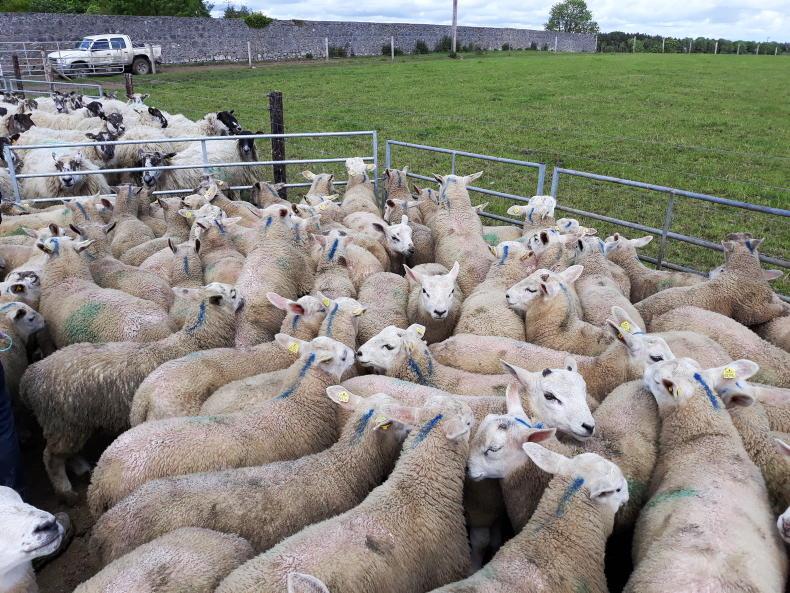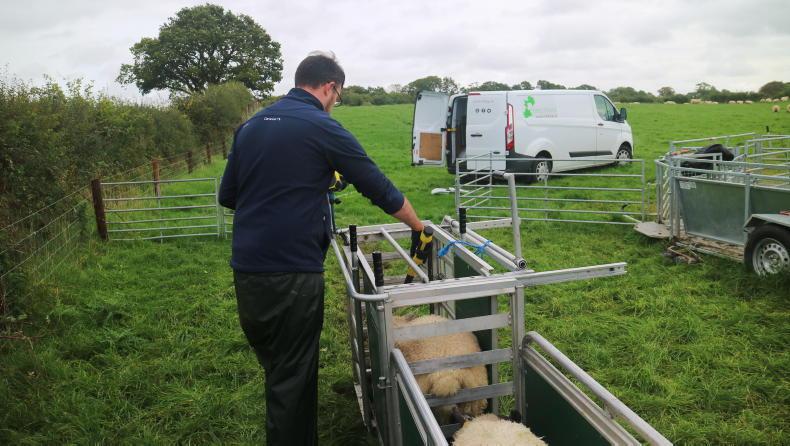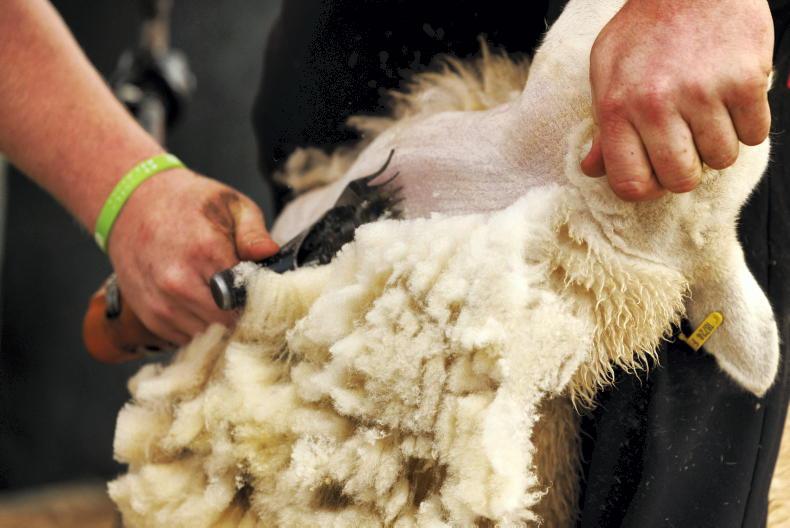The new National Sheep Welfare Scheme was launched this week by Minister for Agriculture Charlie McConalogue.
The one-year scheme offers payment of €8/ewe for completing two mandatory tasks – one category A action from either sheep-shearing or body condition-scoring and a category B action – either plunge-dipping or clostridial disease vaccination.
For participants to be deemed eligible to apply, they must have submitted a 2023 sheep census return by the deadline of 14 February 2024 and submit a Basic Income Support for Sustainability (BISS) application in 2024. The scheme closes for applications at 11.59pm on Tuesday 21 May 2024.
Late applications can be submitted subject to a penalty of 1% for every working day. The final date for submitting late applications is Saturday, 15 June 2024, with such applications on that date subject to a 17% penalty; while on Sunday, 16 June 2024, applications will be subject to a 100% penalty.
Payable number
The number of ewes on which the maximum payment is based, is the higher of the number of ewes recorded on the 2023 sheep census return, or the average of breeding ewe numbers recorded on census returns from 2020 to 2022. This is the number on which tasks must be completed, so records maintained/product purchased should tally with this figure.
As is the case in the Sheep Improvement Scheme, this number must be maintained for the duration of the scheme (1 January to 31 December 2024).
The terms and conditions state that where an applicant has a lower number of sheep now than identified as the maximum payment, or if they wish to carry out the chosen tasks on a lower number of sheep, then they must input this lower number of ewes at the time of application.
A failure to apply for an accurate number of breeding ewes could lead to a penalty and/or no payment under the scheme.
The terms and conditions also advise: “applicants should note that they are required to inform the Department before payment issues or prior to receipt of a notification of an administrative and/or inspection if the number of breeding ewes they hold falls below the scheme payable number. The lower number of breeding ewes will then become the eligible number for payment”.

Where ewes have not been vaccinated for clostridial disease, then lambs can be vaccinated as an alternative.
Penalty schedule
The possible penalty concerning deficient ewe numbers is as follows: “Where the number of breeding ewes determined during an administrative and/or inspection review is lower than the scheme payable number, a double the difference penalty will be imposed”.
For example, if your declared scheme payable number is 100 and administrative review and/or an on-the-spot inspection shows the action has only been completed on 80 head, the number of breeding ewes you will be paid on will be 60 – ie the shortfall of 20 ewes is doubled to 40 ewes.
A payment of €4 is laid out for completing each task. If an action is not fully completed in line with the terms and conditions of the scheme, then it will not be eligible for payment. A 50% penalty is also applied for non-completion of an action, meaning in such cases the maximum payment received will be €2/ewe.
There terms and conditions add that where neither a category A nor a category B action have been completed, no payment will be forthcoming, plus an administrative penalty of 20% (€1.60 per ewe) on the overall amount which would have been payable on the two actions in the scheme year will be imposed.

Condition-scoring must be recorded and where ewes lack condition acted upon.
Scheme actions
While the scheme year runs from 1 January to 31 December, scheme conditions state that all actions must be completed between 1 January 2024 and 15 October 2024. Farmers are advised to carefully select their actions, as it will not be possible to change actions except in ‘exceptional or duly justified cases’.
Category A – sheep-shearing
Sheep-shearing must be carried out on the number of breeding ewes selected as the payable number at application stage, or where reduced thereafter. Documentary evidence will include, but may not be limited to, completion of the scheme action record sheets, receipts from a shearing contractor, if applicable, and/or evidence of the sale of wool to a wool merchant.
The terms and conditions advise that if a farmer knows for whatever reason they cannot meet this deadline (for example winter shearing in December), they should choose the alternative category A option.
Category A - body condition-scoring ewes and appropriate follow-on management
Farmers who select this option must carry it out twice within the timeframes listed below and where appropriate implement remedial action to address ewes identified as thick (BCS 1 and 2). The body condition score (BCS) assessment must be carried out eight weeks apart.
The first assessment must take place between 15 April and 15 July 2024, with the second assessment between 1 August and 15 October 2024. The terms and conditions advise that breeding ewes in the flock with a BCS of one or two should be separated and given access to preferential feeding, such as high-quality grass/forage. It adds that breeding ewes with a low BCS may need to be housed.
The number of breeding ewes identified as one and two should be clearly recorded, along with the assessment dates in the action sheets.
Category B – vaccination of ewes against clostridial diseases +/- pasteurella.
If a farmer selects the vaccination of breeding ewes against clostridial diseases +/- pasteurella option, it must be completed between 1 January 2024 and 15 October 2024. Breeding ewes that have previously received their primary course of vaccines should have received an annual booster or full primary course.
This should take place “four to six weeks before the expected lambing date, to ensure adequate accumulation of protective immunoglobulins in colostrum”.
If all or some of your breeding ewes are not currently in receipt of a clostridial vaccination, you may vaccinate lambs as an alternative. Where you do so, lambs must be vaccinated from three weeks of age and a second booster vaccination must be administered no later than four to six weeks after the first vaccination.
Documentary evidence of completion of this action will include, but not been limited to, completion of the scheme action record sheets and receipts for sufficient vaccination for breeding ewes and/or lambs.
Category B – plunge-dipping to control external parasites.
This action must again take from 1 January to 15 October 2024. Plunge-dipping can be carried out on farm where the flock owner has their own plunge-dip or by a mobile plunge-dipping service operator. The terms and conditions state dipping must not take place eight weeks prior to lambing.
Documentary evidence of completion of this action will include, but not be limited to, completion of the scheme action record sheets, receipts from a contractor if applicable and/or receipts for the purchase of appropriate dipping material.

Numbers shorn must correspond to the payable number. \ Donal O’Leary
Key points
The scheme opened on 8 April and closes for applications at 23.59pm on Tuesday, 21 May 2024.Payment is €8/ewe for mandatory completion of two actions. The number of breeding ewes selected for payment must be maintained across the scheme year.Actions must be completed between 1 January 2024 and 15 October 2024.
The new National Sheep Welfare Scheme was launched this week by Minister for Agriculture Charlie McConalogue.
The one-year scheme offers payment of €8/ewe for completing two mandatory tasks – one category A action from either sheep-shearing or body condition-scoring and a category B action – either plunge-dipping or clostridial disease vaccination.
For participants to be deemed eligible to apply, they must have submitted a 2023 sheep census return by the deadline of 14 February 2024 and submit a Basic Income Support for Sustainability (BISS) application in 2024. The scheme closes for applications at 11.59pm on Tuesday 21 May 2024.
Late applications can be submitted subject to a penalty of 1% for every working day. The final date for submitting late applications is Saturday, 15 June 2024, with such applications on that date subject to a 17% penalty; while on Sunday, 16 June 2024, applications will be subject to a 100% penalty.
Payable number
The number of ewes on which the maximum payment is based, is the higher of the number of ewes recorded on the 2023 sheep census return, or the average of breeding ewe numbers recorded on census returns from 2020 to 2022. This is the number on which tasks must be completed, so records maintained/product purchased should tally with this figure.
As is the case in the Sheep Improvement Scheme, this number must be maintained for the duration of the scheme (1 January to 31 December 2024).
The terms and conditions state that where an applicant has a lower number of sheep now than identified as the maximum payment, or if they wish to carry out the chosen tasks on a lower number of sheep, then they must input this lower number of ewes at the time of application.
A failure to apply for an accurate number of breeding ewes could lead to a penalty and/or no payment under the scheme.
The terms and conditions also advise: “applicants should note that they are required to inform the Department before payment issues or prior to receipt of a notification of an administrative and/or inspection if the number of breeding ewes they hold falls below the scheme payable number. The lower number of breeding ewes will then become the eligible number for payment”.

Where ewes have not been vaccinated for clostridial disease, then lambs can be vaccinated as an alternative.
Penalty schedule
The possible penalty concerning deficient ewe numbers is as follows: “Where the number of breeding ewes determined during an administrative and/or inspection review is lower than the scheme payable number, a double the difference penalty will be imposed”.
For example, if your declared scheme payable number is 100 and administrative review and/or an on-the-spot inspection shows the action has only been completed on 80 head, the number of breeding ewes you will be paid on will be 60 – ie the shortfall of 20 ewes is doubled to 40 ewes.
A payment of €4 is laid out for completing each task. If an action is not fully completed in line with the terms and conditions of the scheme, then it will not be eligible for payment. A 50% penalty is also applied for non-completion of an action, meaning in such cases the maximum payment received will be €2/ewe.
There terms and conditions add that where neither a category A nor a category B action have been completed, no payment will be forthcoming, plus an administrative penalty of 20% (€1.60 per ewe) on the overall amount which would have been payable on the two actions in the scheme year will be imposed.

Condition-scoring must be recorded and where ewes lack condition acted upon.
Scheme actions
While the scheme year runs from 1 January to 31 December, scheme conditions state that all actions must be completed between 1 January 2024 and 15 October 2024. Farmers are advised to carefully select their actions, as it will not be possible to change actions except in ‘exceptional or duly justified cases’.
Category A – sheep-shearing
Sheep-shearing must be carried out on the number of breeding ewes selected as the payable number at application stage, or where reduced thereafter. Documentary evidence will include, but may not be limited to, completion of the scheme action record sheets, receipts from a shearing contractor, if applicable, and/or evidence of the sale of wool to a wool merchant.
The terms and conditions advise that if a farmer knows for whatever reason they cannot meet this deadline (for example winter shearing in December), they should choose the alternative category A option.
Category A - body condition-scoring ewes and appropriate follow-on management
Farmers who select this option must carry it out twice within the timeframes listed below and where appropriate implement remedial action to address ewes identified as thick (BCS 1 and 2). The body condition score (BCS) assessment must be carried out eight weeks apart.
The first assessment must take place between 15 April and 15 July 2024, with the second assessment between 1 August and 15 October 2024. The terms and conditions advise that breeding ewes in the flock with a BCS of one or two should be separated and given access to preferential feeding, such as high-quality grass/forage. It adds that breeding ewes with a low BCS may need to be housed.
The number of breeding ewes identified as one and two should be clearly recorded, along with the assessment dates in the action sheets.
Category B – vaccination of ewes against clostridial diseases +/- pasteurella.
If a farmer selects the vaccination of breeding ewes against clostridial diseases +/- pasteurella option, it must be completed between 1 January 2024 and 15 October 2024. Breeding ewes that have previously received their primary course of vaccines should have received an annual booster or full primary course.
This should take place “four to six weeks before the expected lambing date, to ensure adequate accumulation of protective immunoglobulins in colostrum”.
If all or some of your breeding ewes are not currently in receipt of a clostridial vaccination, you may vaccinate lambs as an alternative. Where you do so, lambs must be vaccinated from three weeks of age and a second booster vaccination must be administered no later than four to six weeks after the first vaccination.
Documentary evidence of completion of this action will include, but not been limited to, completion of the scheme action record sheets and receipts for sufficient vaccination for breeding ewes and/or lambs.
Category B – plunge-dipping to control external parasites.
This action must again take from 1 January to 15 October 2024. Plunge-dipping can be carried out on farm where the flock owner has their own plunge-dip or by a mobile plunge-dipping service operator. The terms and conditions state dipping must not take place eight weeks prior to lambing.
Documentary evidence of completion of this action will include, but not be limited to, completion of the scheme action record sheets, receipts from a contractor if applicable and/or receipts for the purchase of appropriate dipping material.

Numbers shorn must correspond to the payable number. \ Donal O’Leary
Key points
The scheme opened on 8 April and closes for applications at 23.59pm on Tuesday, 21 May 2024.Payment is €8/ewe for mandatory completion of two actions. The number of breeding ewes selected for payment must be maintained across the scheme year.Actions must be completed between 1 January 2024 and 15 October 2024. 








 This is a subscriber-only article
This is a subscriber-only article








SHARING OPTIONS: